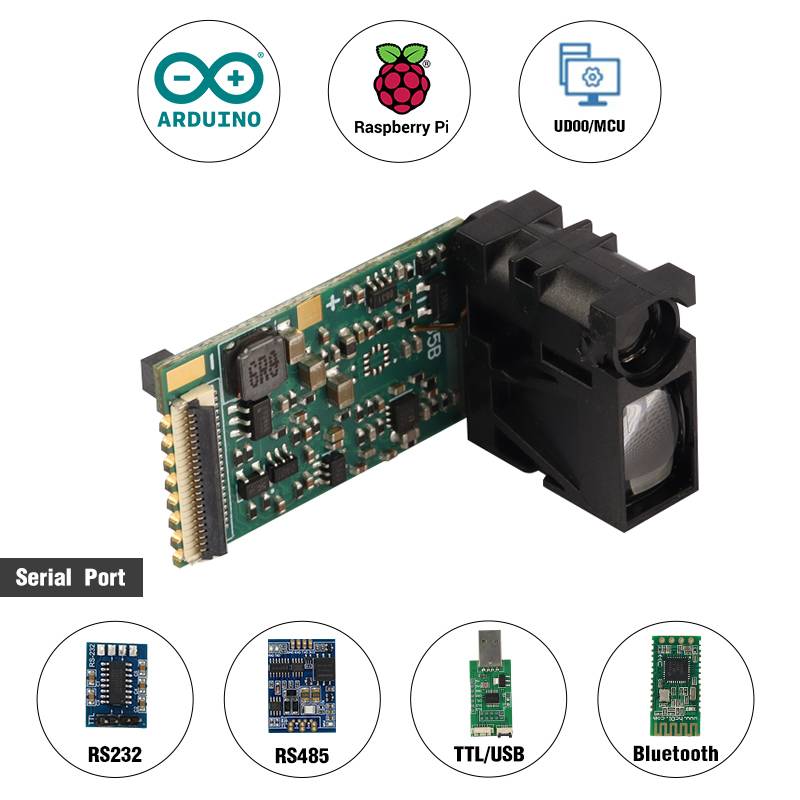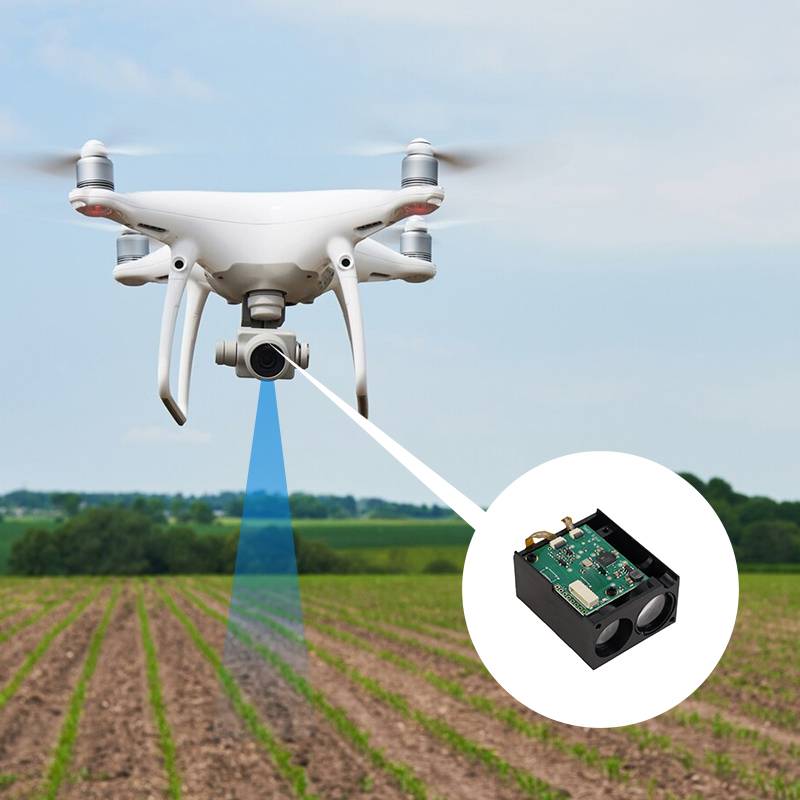Porque é que a interface dos módulos de distância laser é importante
Ao integrar um laser sensor de distância no seu sistema - seja para robótica, automação ou topografia - escolher a interface correta para distância do laser é uma decisão de conceção crítica. A interface tem impacto na velocidade de comunicação, na escalabilidade do sistema, na complexidade da cablagem e na facilidade com que o sensor se liga ao seu microcontrolador, PC ou controlador industrial.
Em meskernel, os nossos produtos personalizáveis módulos de distância laser apoio UARTI2C, USB e até RS232/RS485 - assegurando o ajuste certo para cada aplicação.
O que são interfaces UART, I2C e USB?
Antes de escolher a interface correta para os módulos de distância laser, é importante compreender o que é realmente cada interface. Estes protocolos determinam a forma como o seu sensor de distância por laser comunica com o resto do seu sistema - quer seja um microcontrolador, um controlador industrial ou um PC.
O que é a UART?
O UART (Universal Asynchronous Receiver-Transmitter) é um protocolo de comunicação em série ponto-a-ponto normalmente utilizado em sistemas incorporados. Utiliza apenas duas linhas - TX (transmissão) e RX (receção) - para enviar e receber dados de forma assíncrona, o que significa que não necessita de um sinal de relógio. A maioria microcontroladores como ESP32STM32, e Arduino suportam UART, tornando-o ideal para configurações de sensor único.
Exemplo: Um sensor de distância a laser com uma interface UART envia dados de medição para um controlador de voo num drone.
O que é I2C?
O I2C (Inter-Integrated Circuit) é um protocolo de comunicação síncrono e multi-dispositivo concebido para comunicação de curto alcance entre chips na mesma placa. Utiliza duas linhas - SCL (relógio) e SDA (dados) - e permite que um único dispositivo mestre comunique com vários dispositivos escravos, atribuindo a cada um deles um endereço único. Isto torna-o uma solução que poupa espaço quando se utilizam vários sensores num sistema.
Exemplo: Um braço robótico utiliza vários módulos de distância laser I2C para detetar obstáculos de vários ângulos.
O que é o USB?
O USB (Universal Serial Bus) é um padrão de comunicação plug-and-play de alta velocidade, mais utilizado em PCs e computadores portáteis. Ao contrário do UART e do I2C, o USB fornece dados e energia através do mesmo cabo, tornando-o ideal para ambientes de secretária ou de laboratório. É normalmente utilizado para registo de dados, calibração de sensores ou quando o sensor é operado através de uma GUI ou software de recolha de dados.
Exemplo: Um engenheiro liga um sensor laser USB a um PC para monitorizar as alterações de distância em tempo real utilizando software personalizado.
Comparação de interfaces para módulos de distância laser: UART, I2C e USB
Segue-se uma análise das interfaces mais populares para módulos de distância laser, comparando as suas principais caraterísticas e casos de utilização ideais.
| Caraterística | UART | I2C | USB |
|---|
| Cablagem | 2 fios (TX, RX) | 2 fios (SDA, SCL) | 4 fios (VCC, GND, D+, D-) |
| Velocidade | Até 1 Mbps | Até 3,4 Mbps (modo HS) | Até 480 Mbps (USB 2.0) |
| Comprimento do cabo | Curto a médio | Muito curto | Médio |
| Potência | Necessita de uma fonte externa | Necessita de uma fonte externa | Pode ser alimentado por USB |
| Multi-sensor | Não (apenas ponto a ponto) | Sim (compatível com vários dispositivos) | Não (apenas dispositivo anfitrião) |
| Facilidade de utilização | Configuração simples e amigável para MCU | Endereçamento complexo | Plug-and-play para PCs |
Interface UART para módulos de distância laser
A interface UART para módulos de distância laser é ideal para sistemas incorporados onde um único sensor comunica diretamente com um microcontrolador como o ESP32, STM32 ou Arduino.
Prós:
- Configuração simples
- Baixo consumo de energia e baixo número de pinos
- Ótimo para aplicações em tempo real
Contras:
- Não há suporte para vários dispositivos sem multiplexagem
- Alcance limitado e potencial de ruído
Recomendado para:
- Drones
- Robótica de bricolage
- Dispositivos móveis de medição
Produto popular: Sensor de distância LDL-S- Módulo laser compacto, baseado em UART, com precisão de ±1 mm.
Interface I2C para módulos de distância laser
Se a sua aplicação necessita de vários sensores a comunicar com um único anfitrião, a interface I2C para módulos de distância laser oferece uma solução escalável com apenas dois fios.
Prós:
- Suporta vários dispositivos num único barramento
- Reduz a complexidade da cablagem
- Compatível com a maioria das MCUs
Contras:
- Limitações do comprimento do cabo (recomenda-se <1m)
- Velocidades mais lentas e endereçamento complexo
Recomendado para:
- Distância multiponto deteção
- Conjuntos de sensores compactos
- Sistemas de automação industrial
Produto popular: Sensor de distância laser LDJ- Ideal para braços robóticos, AGVs e sistemas agrícolas inteligentes.
Interface USB para módulos de distância laser
A interface USB para módulos de distância laser é a melhor para ambientes de secretária ou baseados em PC, onde o acesso plug-and-play, velocidades mais elevadas e registo de dados são prioritários.
Prós:
- Transferência rápida de dados
- Alimentado por USB, não necessita de alimentação adicional
- Integração simples com computadores portáteis ou Raspberry Pi
Contras:
- Não é adequado para configurações apenas de MCU incorporadas
- Comprimento do cabo limitado a 5 metros (USB 2.0)
Recomendado para:
- Investigação e medição em laboratório
- Visualização gráfica de dados
- Calibração e ensaio de sensores
Produto popular: Sensor laser USB LDJG 10Hz - Módulo "plug-and-play" ideal para configurações controladas por computador.
Como selecionar a melhor interface para o seu módulo de distância a laser
A escolha da interface correta para o módulo de distância do laser depende dos requisitos do seu sistema. Considere o seguinte:
Plataforma de acolhimento:
Microcontrolador: UART ou I2C
PC ou Raspberry Pi: USB
Número de sensores:
Um sensor: UART ou USB
Vários sensores: I2C
Distância entre dispositivos:
Cabos longos: UART ou USB
Ligações curtas da placa de circuito impresso: I2C
Disponibilidade da fonte de alimentação:
O USB fornece energia e dados
UART/I2C pode necessitar de alimentação externa
Requisitos de velocidade de dados:
Aplicações de alta velocidade: USB
Controlo padrão: UART ou I2C
Meskernel oferece total flexibilidade de interface
Na meskernel, as nossas soluções de alta precisão sensores de distância por laser são concebidos com opções de interface flexíveis, incluindo:
- UART para dispositivos incorporados de baixo consumo
- I2C para redes multi-sensor
- USB para aplicações baseadas em PC
- RS232/RS485 para configurações industriais de longa distância
Todos os nossos módulos oferecem uma precisão de ±1 mm, um design compacto, lasers de classe 1 seguros para os olhos e compatibilidade com ambientes agressivos.





Optimize o seu sistema com a interface certa
Escolher a interface correta para módulos de distância laser não é apenas uma escolha técnica - tem um impacto direto no sucesso do seu projeto. Quer esteja a construir um sistema de recolha de dados de alta velocidade ou uma solução incorporada compacta, a interface define o bom funcionamento do seu sistema.
🔗 Explore a nossa gama completa de módulos de distância laser
📩 Contactar-nos para obter orientação técnica gratuita sobre a seleção de interfaces.